A Comprehensive Analysis of Maternity Pay and Leave Benefits
VerifiedAdded on 2024/05/30
|20
|3497
|116
Report
AI Summary
This research proposal explores the benefits of maternity pay and leave, emphasizing its importance for economic and social stability. It aims to analyze and discuss these benefits, develop an understanding of existing policies, and evaluate areas for improvement. The literature review covers maternity pay and leave in the UK, its impact on maternal outcomes, benefits at companies like IKEA, and its effects on women's labor market outcomes, children, and employers. The research methodology outlines the type of research, data collection methods (questionnaires and interviews), and analyzing tools. The proposal includes a timescale, limitations, and concludes with recommendations for enhancing maternity benefits. It highlights the significance of maternity leave in promoting gender equality, supporting women's health, and fostering a productive workforce, ultimately contributing to a stronger economy. Desklib provides access to similar reports and solved assignments for further study.
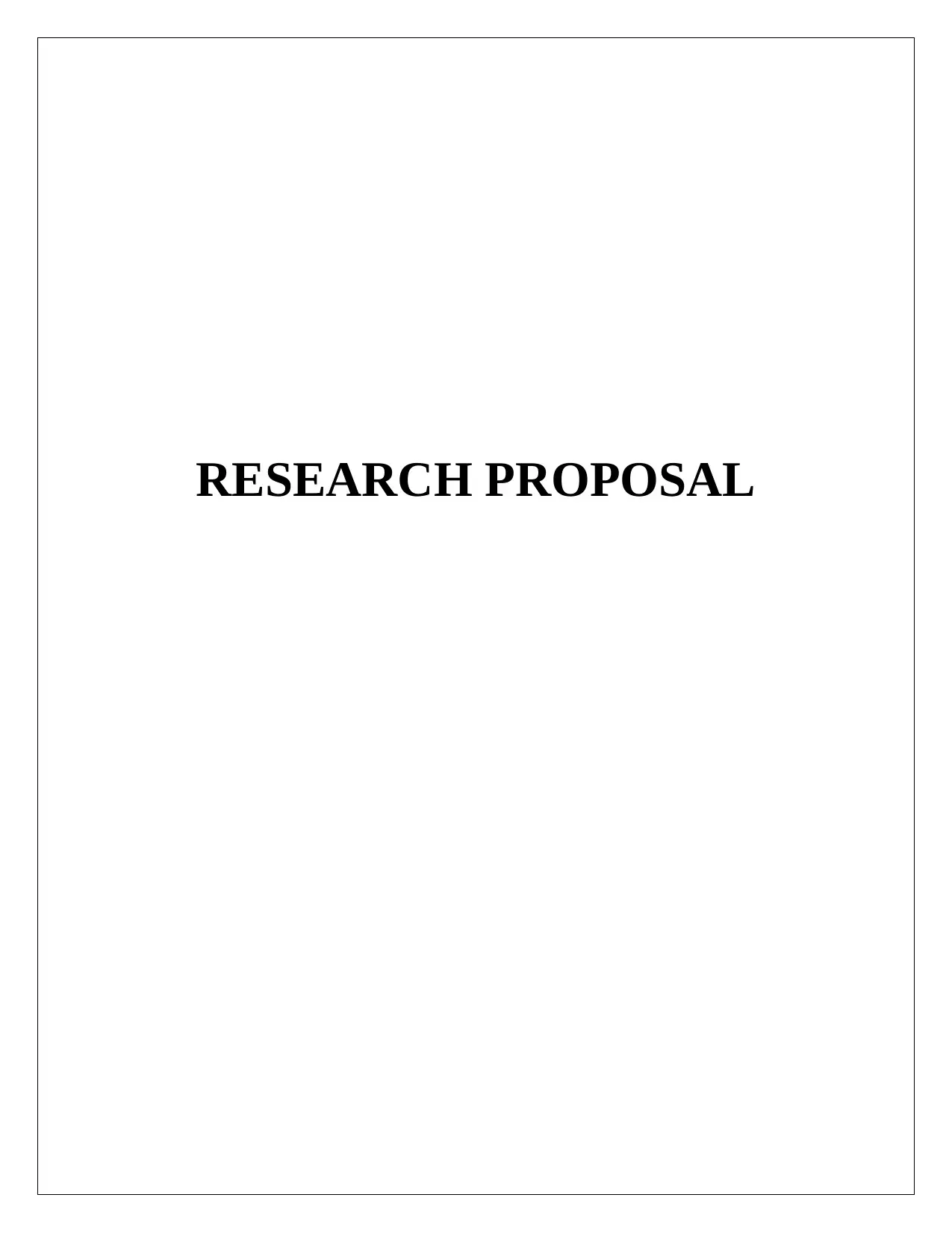
RESEARCH PROPOSAL
Paraphrase This Document
Need a fresh take? Get an instant paraphrase of this document with our AI Paraphraser
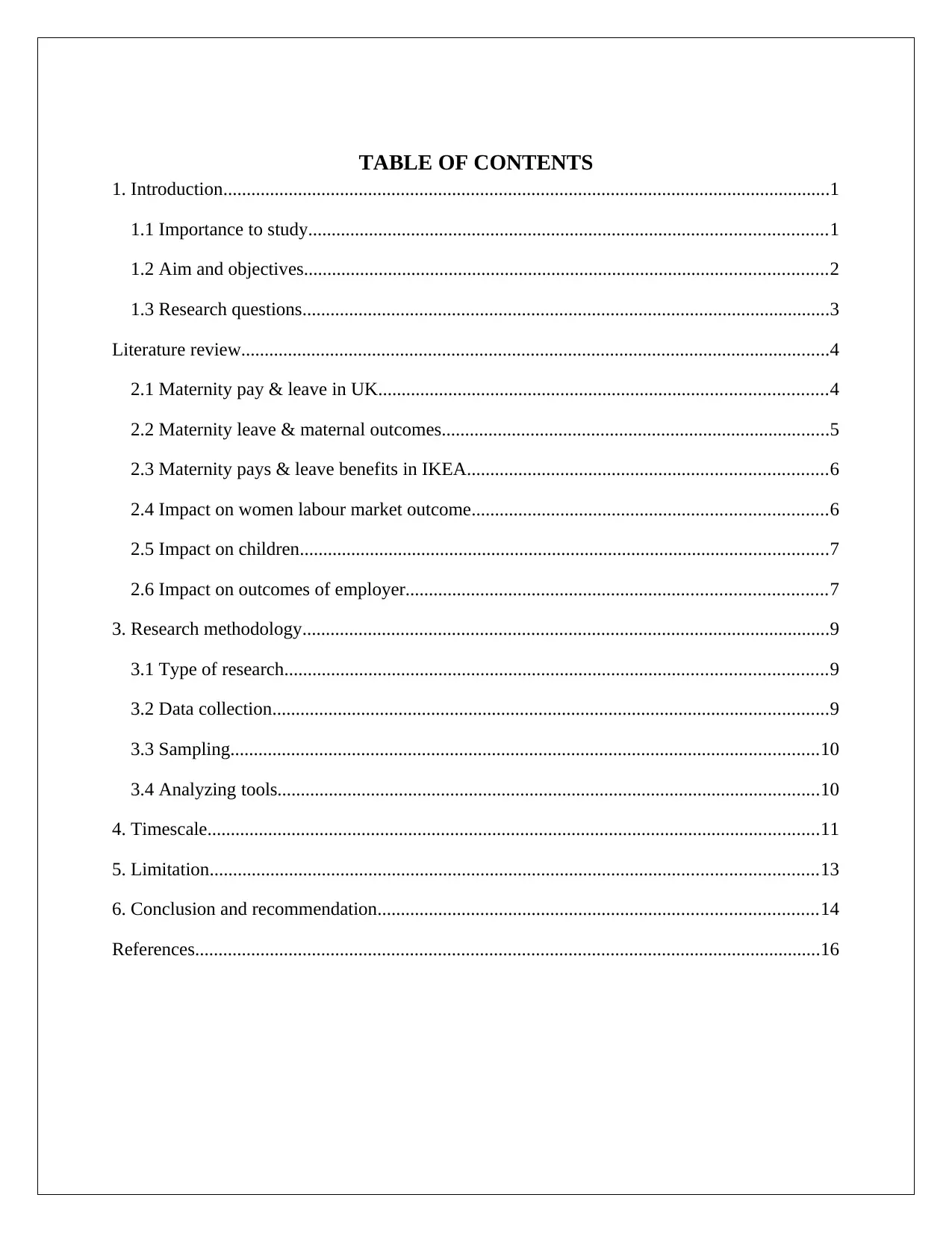
TABLE OF CONTENTS
1. Introduction..................................................................................................................................1
1.1 Importance to study...............................................................................................................1
1.2 Aim and objectives................................................................................................................2
1.3 Research questions.................................................................................................................3
Literature review..............................................................................................................................4
2.1 Maternity pay & leave in UK................................................................................................4
2.2 Maternity leave & maternal outcomes...................................................................................5
2.3 Maternity pays & leave benefits in IKEA.............................................................................6
2.4 Impact on women labour market outcome............................................................................6
2.5 Impact on children.................................................................................................................7
2.6 Impact on outcomes of employer..........................................................................................7
3. Research methodology.................................................................................................................9
3.1 Type of research....................................................................................................................9
3.2 Data collection.......................................................................................................................9
3.3 Sampling..............................................................................................................................10
3.4 Analyzing tools....................................................................................................................10
4. Timescale...................................................................................................................................11
5. Limitation..................................................................................................................................13
6. Conclusion and recommendation..............................................................................................14
References......................................................................................................................................16
1. Introduction..................................................................................................................................1
1.1 Importance to study...............................................................................................................1
1.2 Aim and objectives................................................................................................................2
1.3 Research questions.................................................................................................................3
Literature review..............................................................................................................................4
2.1 Maternity pay & leave in UK................................................................................................4
2.2 Maternity leave & maternal outcomes...................................................................................5
2.3 Maternity pays & leave benefits in IKEA.............................................................................6
2.4 Impact on women labour market outcome............................................................................6
2.5 Impact on children.................................................................................................................7
2.6 Impact on outcomes of employer..........................................................................................7
3. Research methodology.................................................................................................................9
3.1 Type of research....................................................................................................................9
3.2 Data collection.......................................................................................................................9
3.3 Sampling..............................................................................................................................10
3.4 Analyzing tools....................................................................................................................10
4. Timescale...................................................................................................................................11
5. Limitation..................................................................................................................................13
6. Conclusion and recommendation..............................................................................................14
References......................................................................................................................................16
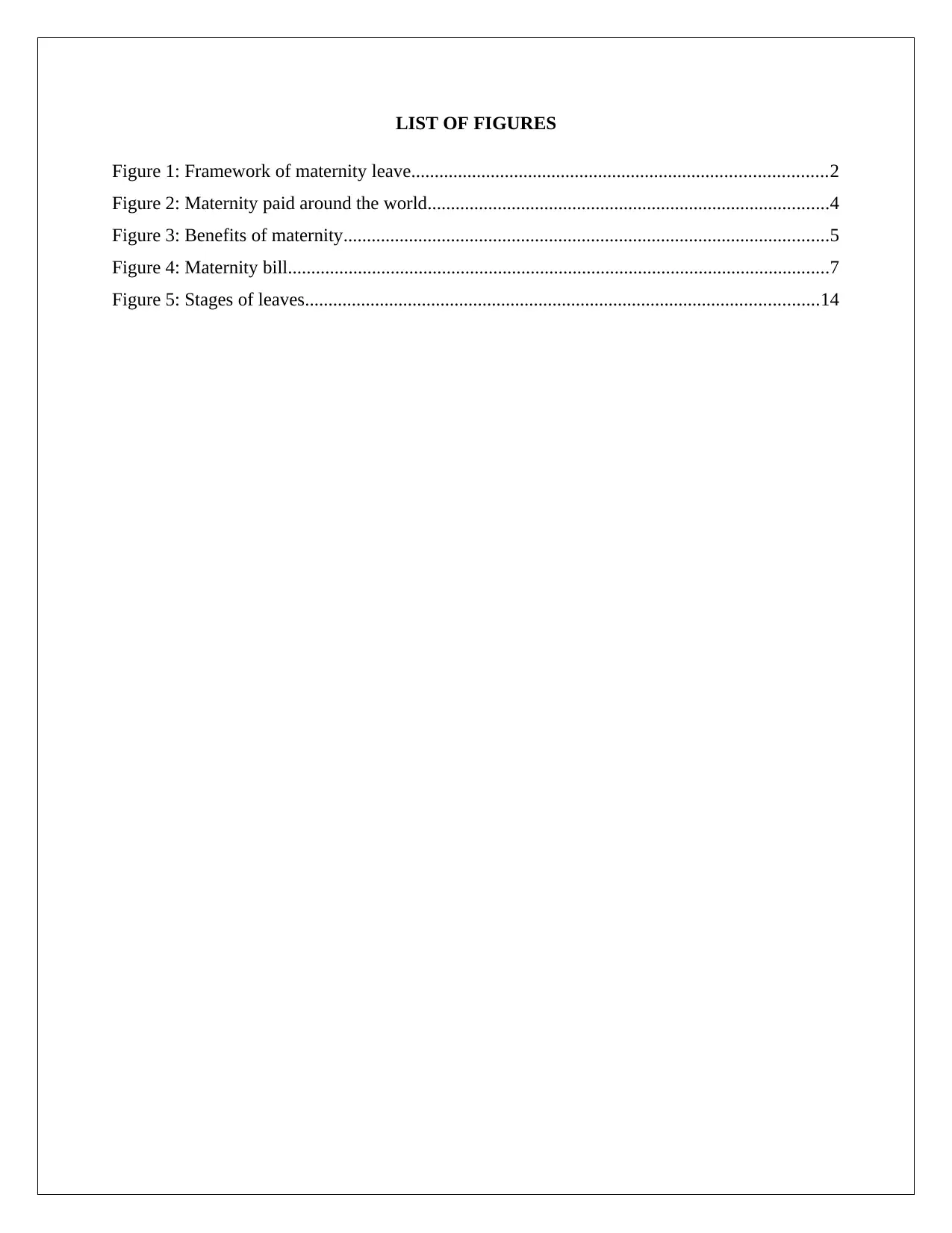
LIST OF FIGURES
Figure 1: Framework of maternity leave.........................................................................................2
Figure 2: Maternity paid around the world......................................................................................4
Figure 3: Benefits of maternity........................................................................................................5
Figure 4: Maternity bill....................................................................................................................7
Figure 5: Stages of leaves..............................................................................................................14
Figure 1: Framework of maternity leave.........................................................................................2
Figure 2: Maternity paid around the world......................................................................................4
Figure 3: Benefits of maternity........................................................................................................5
Figure 4: Maternity bill....................................................................................................................7
Figure 5: Stages of leaves..............................................................................................................14
⊘ This is a preview!⊘
Do you want full access?
Subscribe today to unlock all pages.

Trusted by 1+ million students worldwide
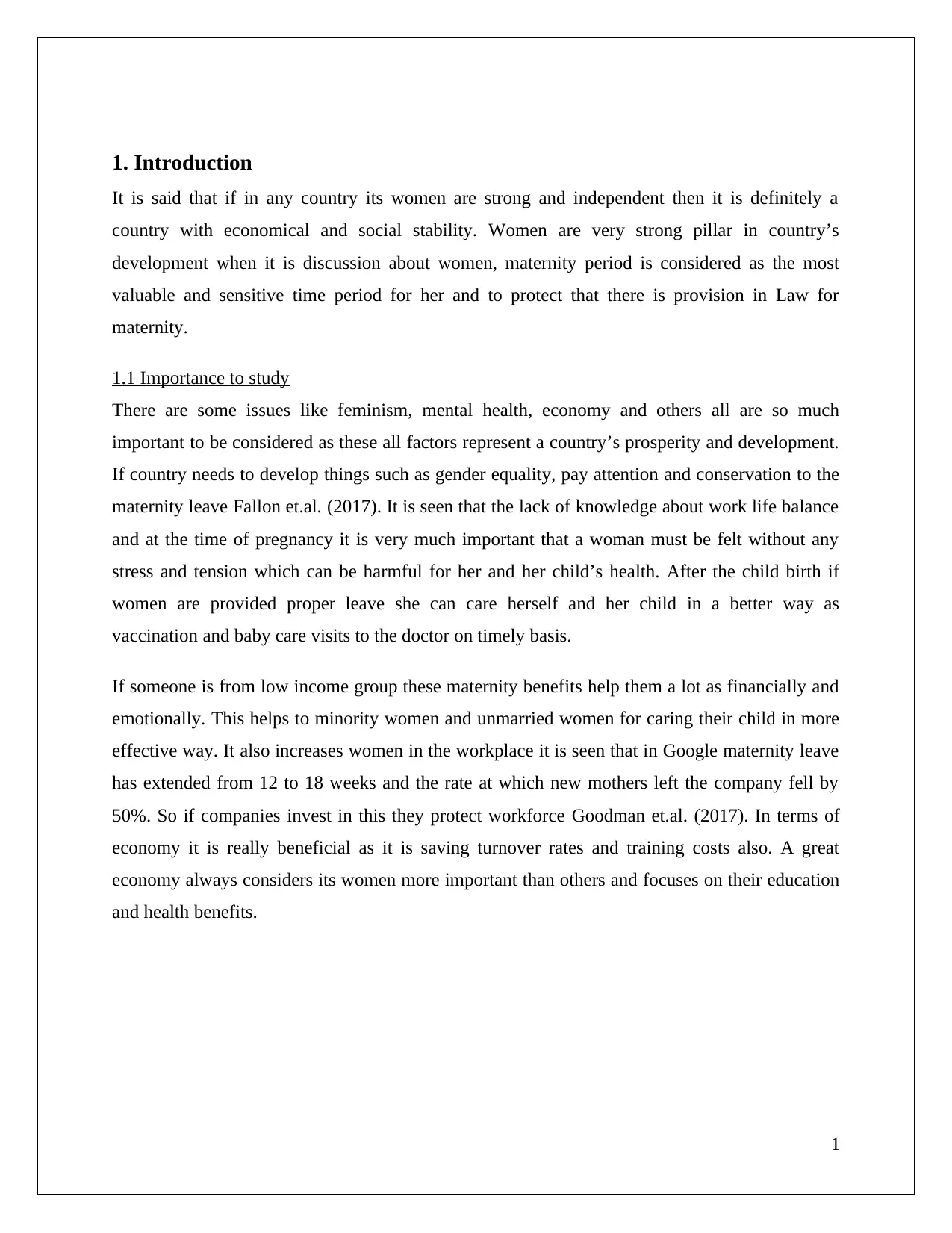
1. Introduction
It is said that if in any country its women are strong and independent then it is definitely a
country with economical and social stability. Women are very strong pillar in country’s
development when it is discussion about women, maternity period is considered as the most
valuable and sensitive time period for her and to protect that there is provision in Law for
maternity.
1.1 Importance to study
There are some issues like feminism, mental health, economy and others all are so much
important to be considered as these all factors represent a country’s prosperity and development.
If country needs to develop things such as gender equality, pay attention and conservation to the
maternity leave Fallon et.al. (2017). It is seen that the lack of knowledge about work life balance
and at the time of pregnancy it is very much important that a woman must be felt without any
stress and tension which can be harmful for her and her child’s health. After the child birth if
women are provided proper leave she can care herself and her child in a better way as
vaccination and baby care visits to the doctor on timely basis.
If someone is from low income group these maternity benefits help them a lot as financially and
emotionally. This helps to minority women and unmarried women for caring their child in more
effective way. It also increases women in the workplace it is seen that in Google maternity leave
has extended from 12 to 18 weeks and the rate at which new mothers left the company fell by
50%. So if companies invest in this they protect workforce Goodman et.al. (2017). In terms of
economy it is really beneficial as it is saving turnover rates and training costs also. A great
economy always considers its women more important than others and focuses on their education
and health benefits.
1
It is said that if in any country its women are strong and independent then it is definitely a
country with economical and social stability. Women are very strong pillar in country’s
development when it is discussion about women, maternity period is considered as the most
valuable and sensitive time period for her and to protect that there is provision in Law for
maternity.
1.1 Importance to study
There are some issues like feminism, mental health, economy and others all are so much
important to be considered as these all factors represent a country’s prosperity and development.
If country needs to develop things such as gender equality, pay attention and conservation to the
maternity leave Fallon et.al. (2017). It is seen that the lack of knowledge about work life balance
and at the time of pregnancy it is very much important that a woman must be felt without any
stress and tension which can be harmful for her and her child’s health. After the child birth if
women are provided proper leave she can care herself and her child in a better way as
vaccination and baby care visits to the doctor on timely basis.
If someone is from low income group these maternity benefits help them a lot as financially and
emotionally. This helps to minority women and unmarried women for caring their child in more
effective way. It also increases women in the workplace it is seen that in Google maternity leave
has extended from 12 to 18 weeks and the rate at which new mothers left the company fell by
50%. So if companies invest in this they protect workforce Goodman et.al. (2017). In terms of
economy it is really beneficial as it is saving turnover rates and training costs also. A great
economy always considers its women more important than others and focuses on their education
and health benefits.
1
Paraphrase This Document
Need a fresh take? Get an instant paraphrase of this document with our AI Paraphraser

Figure 1: Framework of maternity leave
(Source: Cooperation and economic development, 2018)
So it is very clear that this study is really important to spread the awareness and developing
understanding regarding the maternity and women health benefits. It must be included in the
study because women’s health cannot be ignored because women are roots for everything in the
world she must be taken care in precious way Grimshaw and Rubery, (2015). So here in this
research study it is discussed that why maternity leave are beneficial in every manner.
2
(Source: Cooperation and economic development, 2018)
So it is very clear that this study is really important to spread the awareness and developing
understanding regarding the maternity and women health benefits. It must be included in the
study because women’s health cannot be ignored because women are roots for everything in the
world she must be taken care in precious way Grimshaw and Rubery, (2015). So here in this
research study it is discussed that why maternity leave are beneficial in every manner.
2
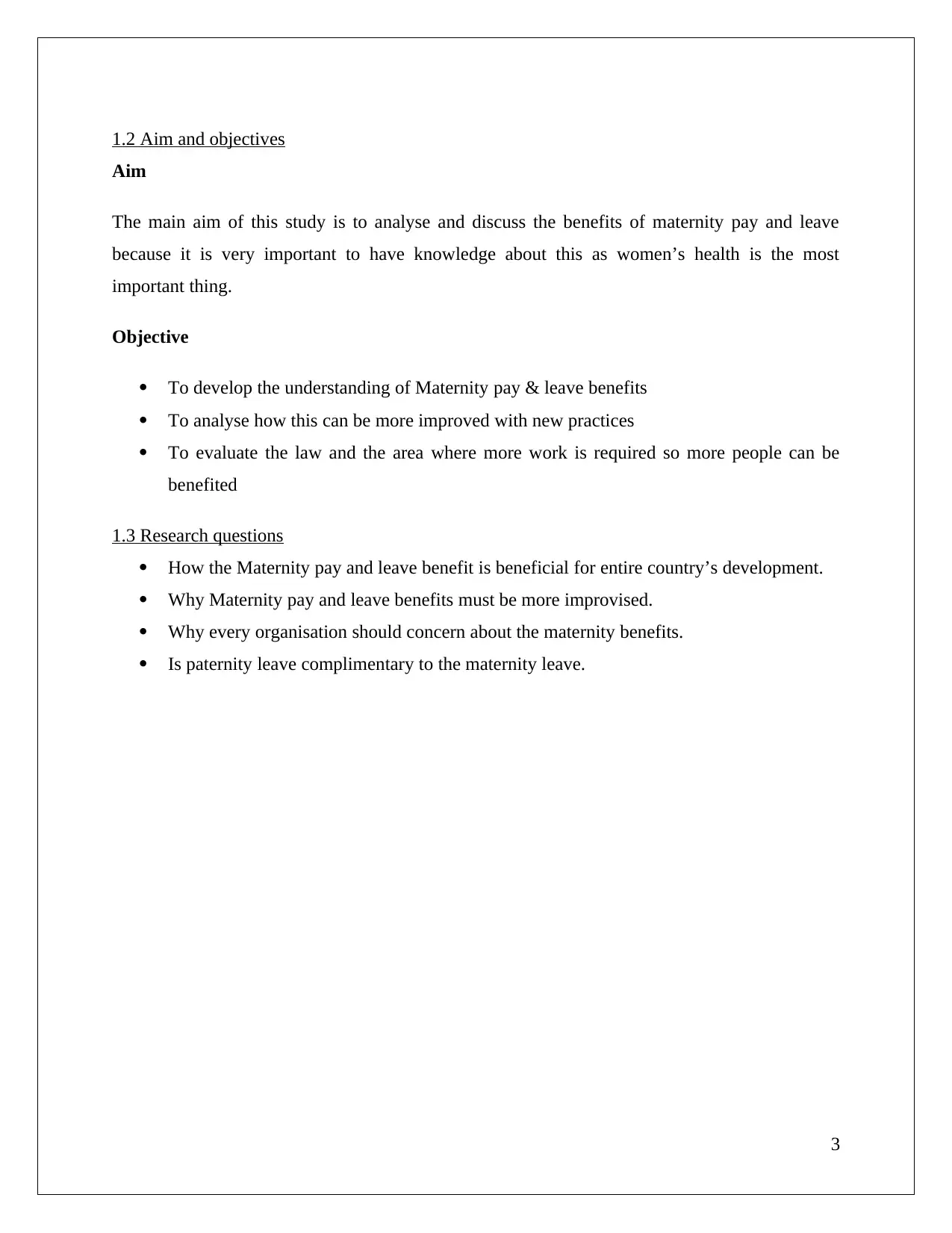
1.2 Aim and objectives
Aim
The main aim of this study is to analyse and discuss the benefits of maternity pay and leave
because it is very important to have knowledge about this as women’s health is the most
important thing.
Objective
To develop the understanding of Maternity pay & leave benefits
To analyse how this can be more improved with new practices
To evaluate the law and the area where more work is required so more people can be
benefited
1.3 Research questions
How the Maternity pay and leave benefit is beneficial for entire country’s development.
Why Maternity pay and leave benefits must be more improvised.
Why every organisation should concern about the maternity benefits.
Is paternity leave complimentary to the maternity leave.
3
Aim
The main aim of this study is to analyse and discuss the benefits of maternity pay and leave
because it is very important to have knowledge about this as women’s health is the most
important thing.
Objective
To develop the understanding of Maternity pay & leave benefits
To analyse how this can be more improved with new practices
To evaluate the law and the area where more work is required so more people can be
benefited
1.3 Research questions
How the Maternity pay and leave benefit is beneficial for entire country’s development.
Why Maternity pay and leave benefits must be more improvised.
Why every organisation should concern about the maternity benefits.
Is paternity leave complimentary to the maternity leave.
3
⊘ This is a preview!⊘
Do you want full access?
Subscribe today to unlock all pages.

Trusted by 1+ million students worldwide
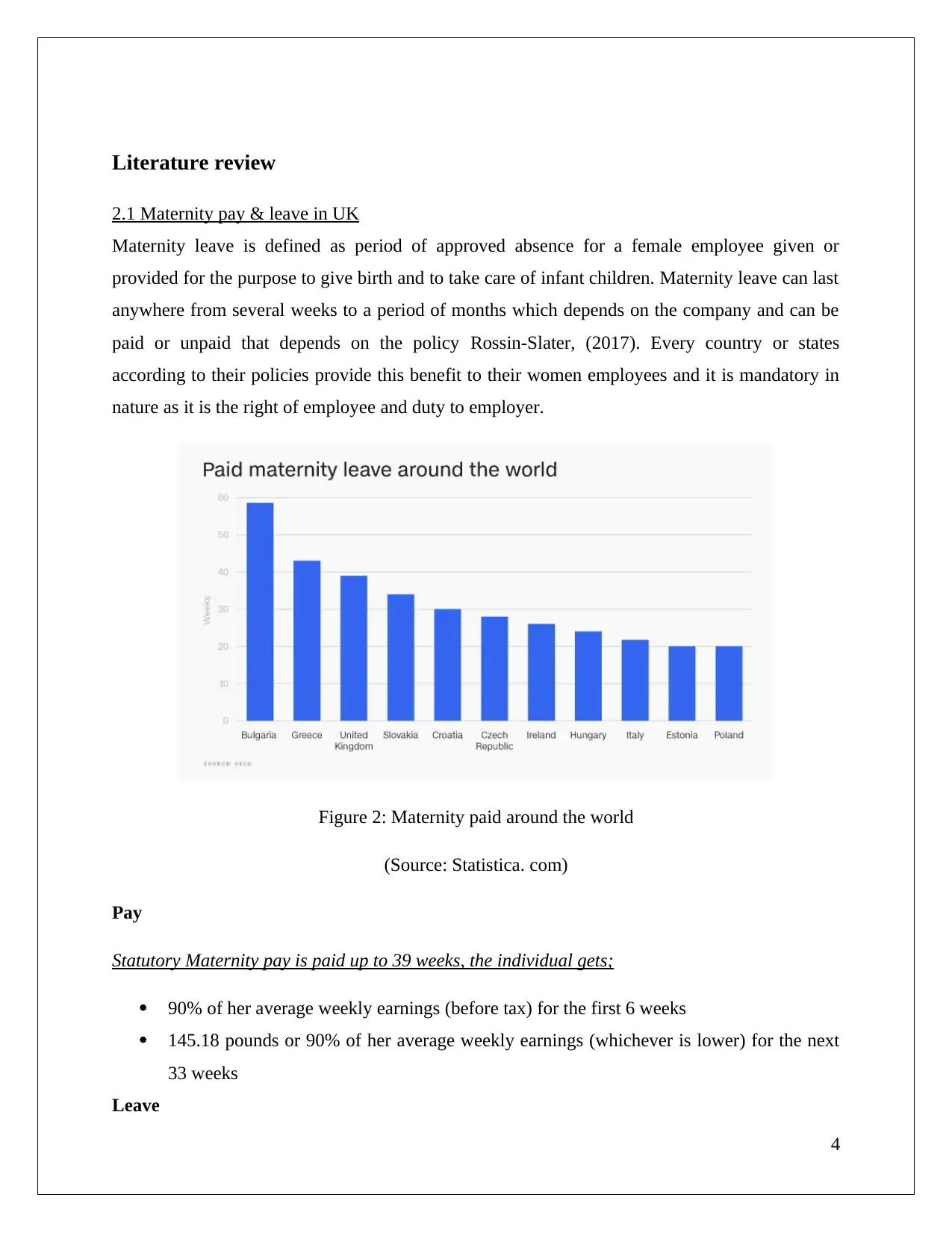
Literature review
2.1 Maternity pay & leave in UK
Maternity leave is defined as period of approved absence for a female employee given or
provided for the purpose to give birth and to take care of infant children. Maternity leave can last
anywhere from several weeks to a period of months which depends on the company and can be
paid or unpaid that depends on the policy Rossin-Slater, (2017). Every country or states
according to their policies provide this benefit to their women employees and it is mandatory in
nature as it is the right of employee and duty to employer.
Figure 2: Maternity paid around the world
(Source: Statistica. com)
Pay
Statutory Maternity pay is paid up to 39 weeks, the individual gets;
90% of her average weekly earnings (before tax) for the first 6 weeks
145.18 pounds or 90% of her average weekly earnings (whichever is lower) for the next
33 weeks
Leave
4
2.1 Maternity pay & leave in UK
Maternity leave is defined as period of approved absence for a female employee given or
provided for the purpose to give birth and to take care of infant children. Maternity leave can last
anywhere from several weeks to a period of months which depends on the company and can be
paid or unpaid that depends on the policy Rossin-Slater, (2017). Every country or states
according to their policies provide this benefit to their women employees and it is mandatory in
nature as it is the right of employee and duty to employer.
Figure 2: Maternity paid around the world
(Source: Statistica. com)
Pay
Statutory Maternity pay is paid up to 39 weeks, the individual gets;
90% of her average weekly earnings (before tax) for the first 6 weeks
145.18 pounds or 90% of her average weekly earnings (whichever is lower) for the next
33 weeks
Leave
4
Paraphrase This Document
Need a fresh take? Get an instant paraphrase of this document with our AI Paraphraser
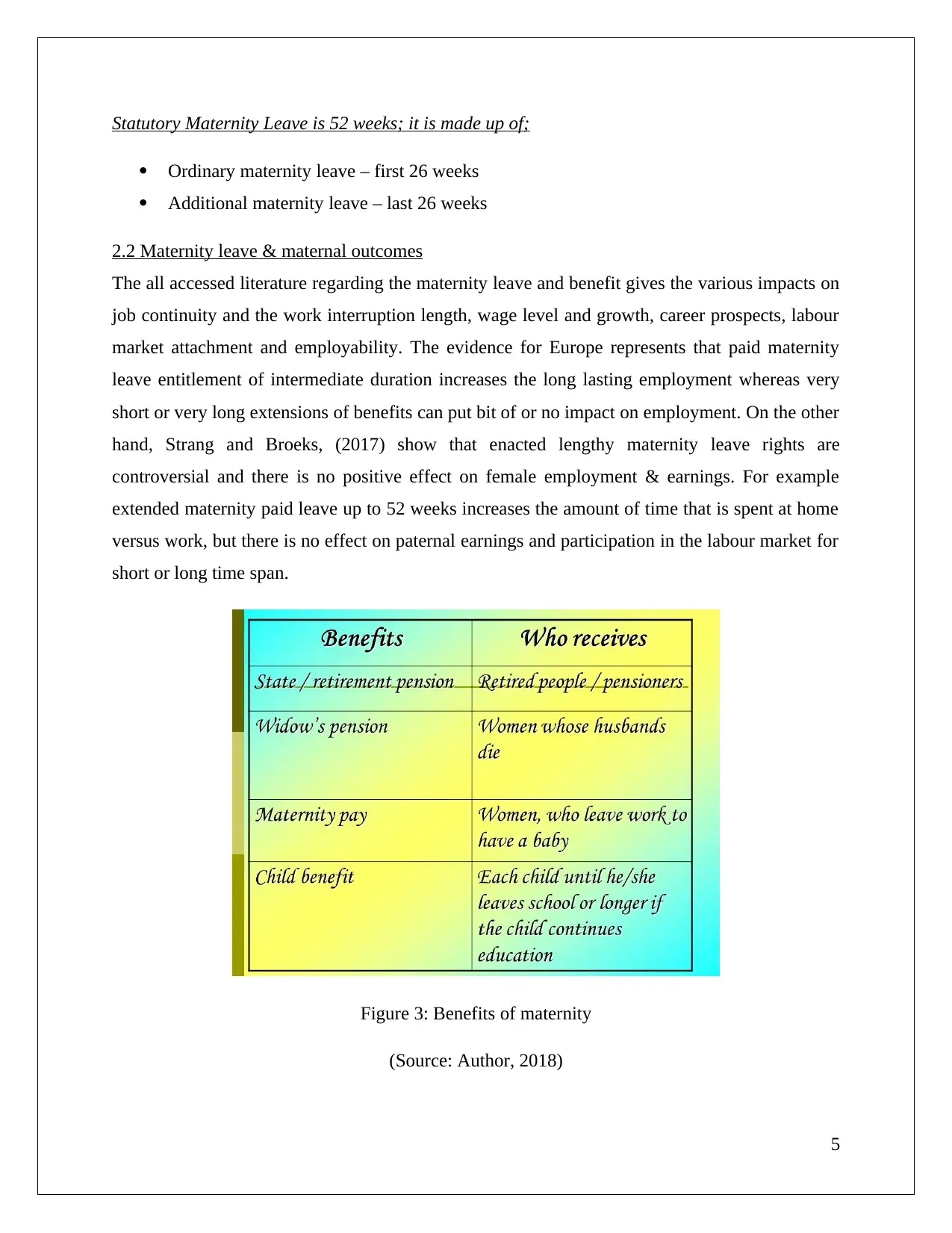
Statutory Maternity Leave is 52 weeks; it is made up of;
Ordinary maternity leave – first 26 weeks
Additional maternity leave – last 26 weeks
2.2 Maternity leave & maternal outcomes
The all accessed literature regarding the maternity leave and benefit gives the various impacts on
job continuity and the work interruption length, wage level and growth, career prospects, labour
market attachment and employability. The evidence for Europe represents that paid maternity
leave entitlement of intermediate duration increases the long lasting employment whereas very
short or very long extensions of benefits can put bit of or no impact on employment. On the other
hand, Strang and Broeks, (2017) show that enacted lengthy maternity leave rights are
controversial and there is no positive effect on female employment & earnings. For example
extended maternity paid leave up to 52 weeks increases the amount of time that is spent at home
versus work, but there is no effect on paternal earnings and participation in the labour market for
short or long time span.
Figure 3: Benefits of maternity
(Source: Author, 2018)
5
Ordinary maternity leave – first 26 weeks
Additional maternity leave – last 26 weeks
2.2 Maternity leave & maternal outcomes
The all accessed literature regarding the maternity leave and benefit gives the various impacts on
job continuity and the work interruption length, wage level and growth, career prospects, labour
market attachment and employability. The evidence for Europe represents that paid maternity
leave entitlement of intermediate duration increases the long lasting employment whereas very
short or very long extensions of benefits can put bit of or no impact on employment. On the other
hand, Strang and Broeks, (2017) show that enacted lengthy maternity leave rights are
controversial and there is no positive effect on female employment & earnings. For example
extended maternity paid leave up to 52 weeks increases the amount of time that is spent at home
versus work, but there is no effect on paternal earnings and participation in the labour market for
short or long time span.
Figure 3: Benefits of maternity
(Source: Author, 2018)
5
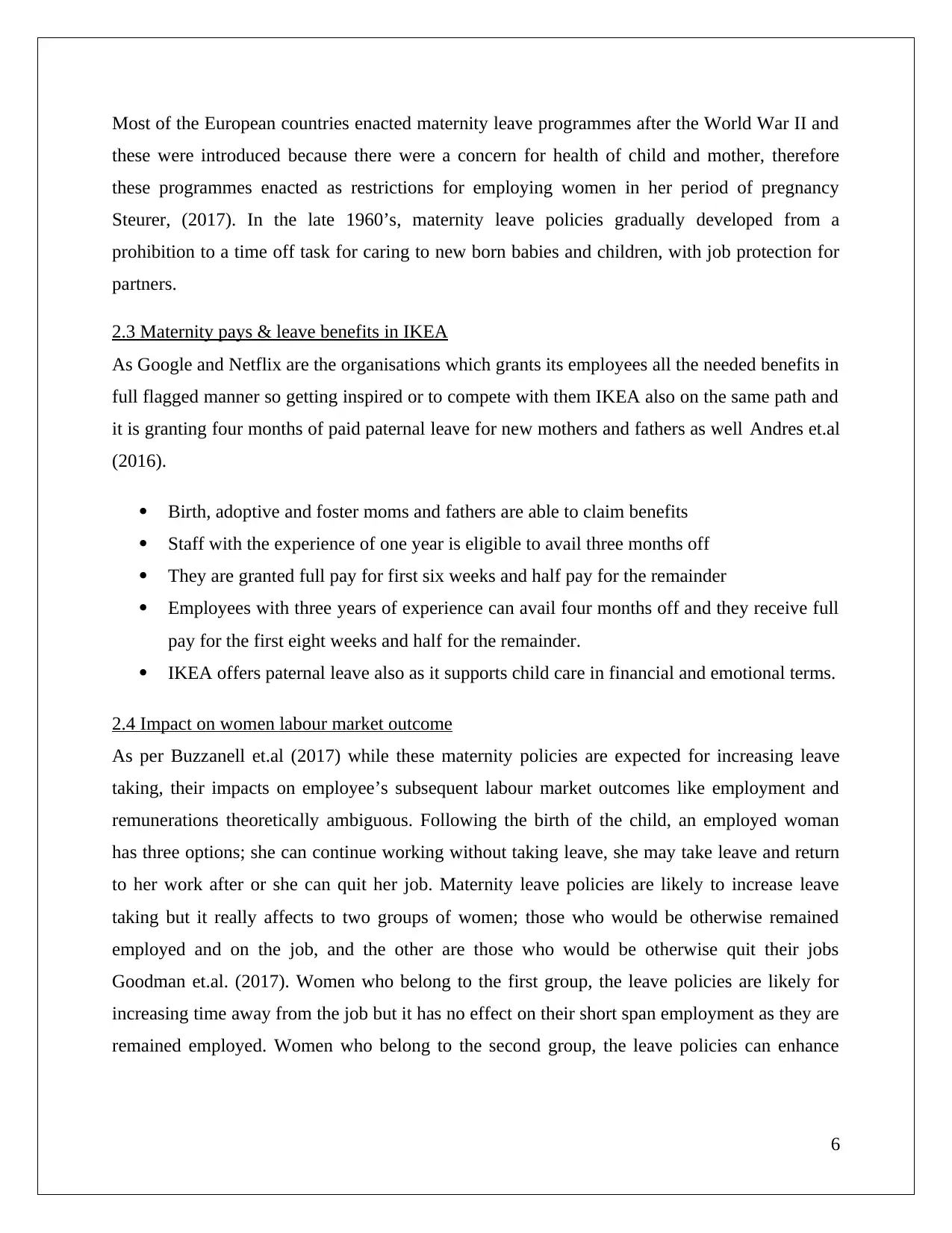
Most of the European countries enacted maternity leave programmes after the World War II and
these were introduced because there were a concern for health of child and mother, therefore
these programmes enacted as restrictions for employing women in her period of pregnancy
Steurer, (2017). In the late 1960’s, maternity leave policies gradually developed from a
prohibition to a time off task for caring to new born babies and children, with job protection for
partners.
2.3 Maternity pays & leave benefits in IKEA
As Google and Netflix are the organisations which grants its employees all the needed benefits in
full flagged manner so getting inspired or to compete with them IKEA also on the same path and
it is granting four months of paid paternal leave for new mothers and fathers as well Andres et.al
(2016).
Birth, adoptive and foster moms and fathers are able to claim benefits
Staff with the experience of one year is eligible to avail three months off
They are granted full pay for first six weeks and half pay for the remainder
Employees with three years of experience can avail four months off and they receive full
pay for the first eight weeks and half for the remainder.
IKEA offers paternal leave also as it supports child care in financial and emotional terms.
2.4 Impact on women labour market outcome
As per Buzzanell et.al (2017) while these maternity policies are expected for increasing leave
taking, their impacts on employee’s subsequent labour market outcomes like employment and
remunerations theoretically ambiguous. Following the birth of the child, an employed woman
has three options; she can continue working without taking leave, she may take leave and return
to her work after or she can quit her job. Maternity leave policies are likely to increase leave
taking but it really affects to two groups of women; those who would be otherwise remained
employed and on the job, and the other are those who would be otherwise quit their jobs
Goodman et.al. (2017). Women who belong to the first group, the leave policies are likely for
increasing time away from the job but it has no effect on their short span employment as they are
remained employed. Women who belong to the second group, the leave policies can enhance
6
these were introduced because there were a concern for health of child and mother, therefore
these programmes enacted as restrictions for employing women in her period of pregnancy
Steurer, (2017). In the late 1960’s, maternity leave policies gradually developed from a
prohibition to a time off task for caring to new born babies and children, with job protection for
partners.
2.3 Maternity pays & leave benefits in IKEA
As Google and Netflix are the organisations which grants its employees all the needed benefits in
full flagged manner so getting inspired or to compete with them IKEA also on the same path and
it is granting four months of paid paternal leave for new mothers and fathers as well Andres et.al
(2016).
Birth, adoptive and foster moms and fathers are able to claim benefits
Staff with the experience of one year is eligible to avail three months off
They are granted full pay for first six weeks and half pay for the remainder
Employees with three years of experience can avail four months off and they receive full
pay for the first eight weeks and half for the remainder.
IKEA offers paternal leave also as it supports child care in financial and emotional terms.
2.4 Impact on women labour market outcome
As per Buzzanell et.al (2017) while these maternity policies are expected for increasing leave
taking, their impacts on employee’s subsequent labour market outcomes like employment and
remunerations theoretically ambiguous. Following the birth of the child, an employed woman
has three options; she can continue working without taking leave, she may take leave and return
to her work after or she can quit her job. Maternity leave policies are likely to increase leave
taking but it really affects to two groups of women; those who would be otherwise remained
employed and on the job, and the other are those who would be otherwise quit their jobs
Goodman et.al. (2017). Women who belong to the first group, the leave policies are likely for
increasing time away from the job but it has no effect on their short span employment as they are
remained employed. Women who belong to the second group, the leave policies can enhance
6
⊘ This is a preview!⊘
Do you want full access?
Subscribe today to unlock all pages.

Trusted by 1+ million students worldwide

short run employment as some out of them can opt for staying employed and avail leave instead
of quitting jobs.
2.5 Impact on children
Figure 4: Maternity bill
(Source: Government.uk.in, 2018)
To help the families is the main goal of the policies of maternity. There are several channels
through which children can be impacted as the guarantee of leave decreases the stress during the
pregnancy that is good for child health at the birth time. Leave also increases the time amount
that a mother can spend with her child after child birth as a result mother can provide good
breastfeed care to her child and pamper him when he is sick apart from that it helps in financial
state of the family in monetary terms an in the material things requirement manner. As per
Grimshaw and Rubery, (2015) show that lower the maternity leave policies are the reason for
low morality of children. These kinds of studies and researches give guidance on what must be
the exact time duration of the maternity and parental leave so the new born child can be cared
with best possible way.
2.6 Impact on outcomes of employer
The currently available literature on effects of the maternity policies on the employer is very
limited in nature as some of the information on employer’s experience with PFL programmes
that are financed through the employee payroll contributions. According to Dahl et.al. (2016)
have given their conclusion and recommendations regarding this as the employees are more
7
of quitting jobs.
2.5 Impact on children
Figure 4: Maternity bill
(Source: Government.uk.in, 2018)
To help the families is the main goal of the policies of maternity. There are several channels
through which children can be impacted as the guarantee of leave decreases the stress during the
pregnancy that is good for child health at the birth time. Leave also increases the time amount
that a mother can spend with her child after child birth as a result mother can provide good
breastfeed care to her child and pamper him when he is sick apart from that it helps in financial
state of the family in monetary terms an in the material things requirement manner. As per
Grimshaw and Rubery, (2015) show that lower the maternity leave policies are the reason for
low morality of children. These kinds of studies and researches give guidance on what must be
the exact time duration of the maternity and parental leave so the new born child can be cared
with best possible way.
2.6 Impact on outcomes of employer
The currently available literature on effects of the maternity policies on the employer is very
limited in nature as some of the information on employer’s experience with PFL programmes
that are financed through the employee payroll contributions. According to Dahl et.al. (2016)
have given their conclusion and recommendations regarding this as the employees are more
7
Paraphrase This Document
Need a fresh take? Get an instant paraphrase of this document with our AI Paraphraser
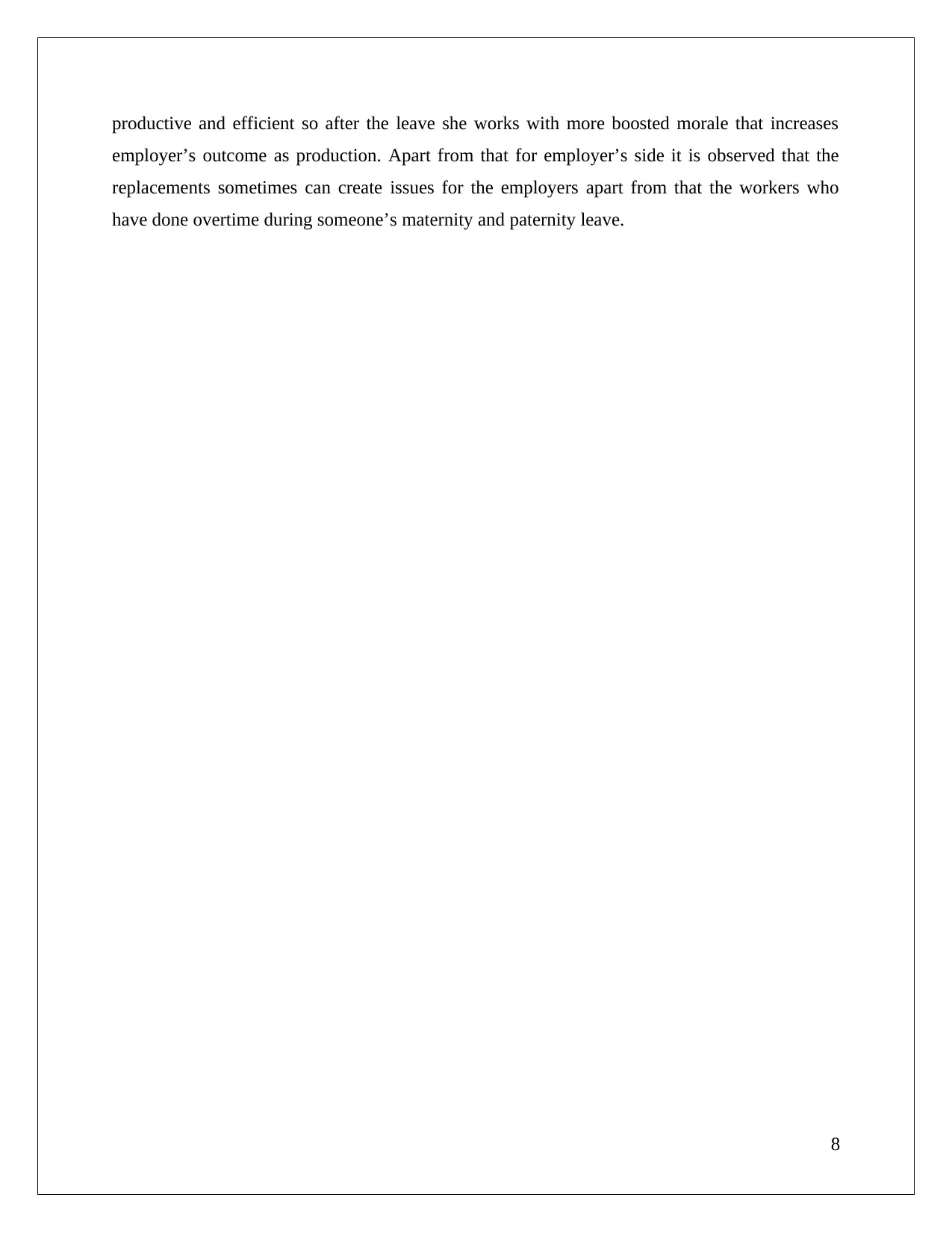
productive and efficient so after the leave she works with more boosted morale that increases
employer’s outcome as production. Apart from that for employer’s side it is observed that the
replacements sometimes can create issues for the employers apart from that the workers who
have done overtime during someone’s maternity and paternity leave.
8
employer’s outcome as production. Apart from that for employer’s side it is observed that the
replacements sometimes can create issues for the employers apart from that the workers who
have done overtime during someone’s maternity and paternity leave.
8
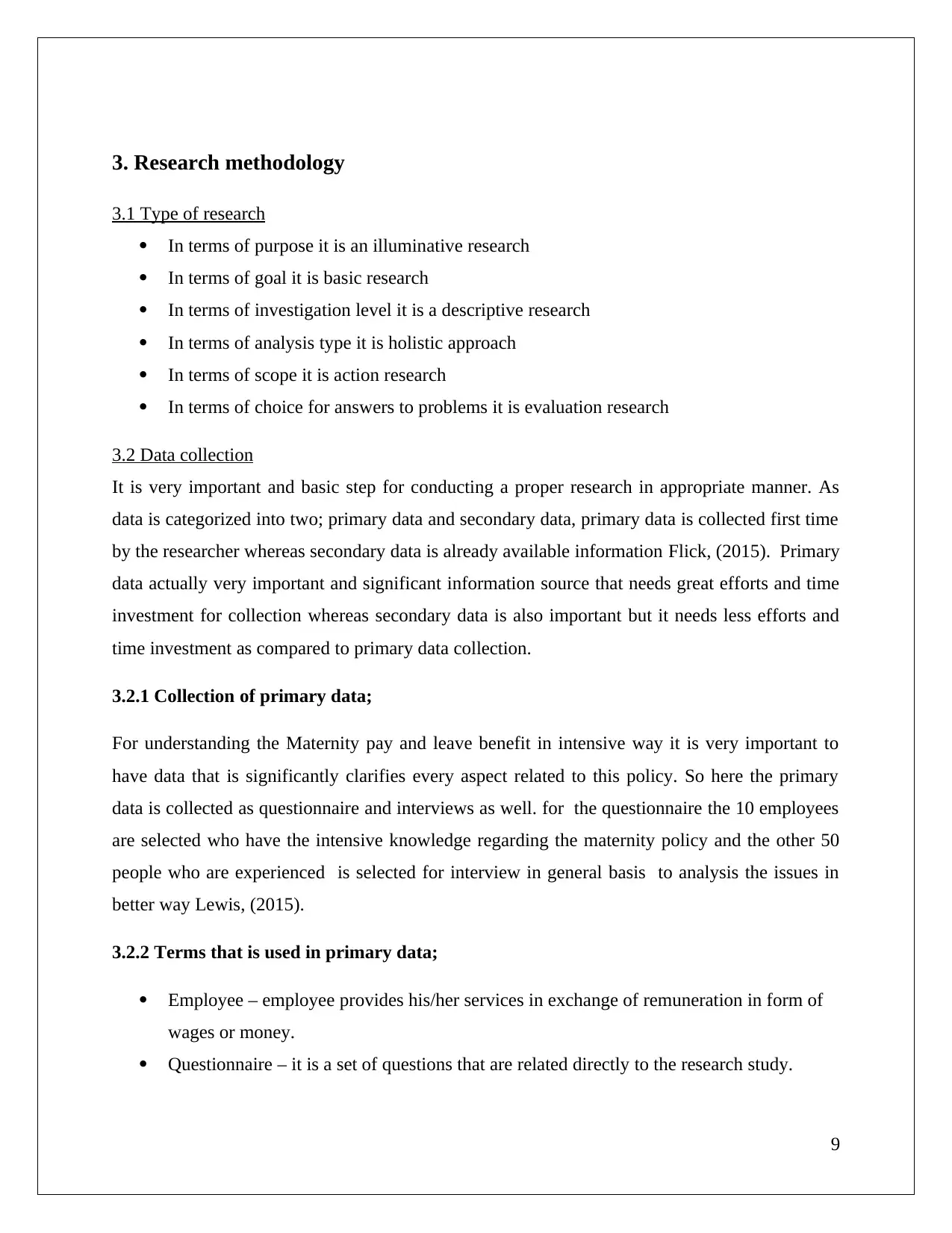
3. Research methodology
3.1 Type of research
In terms of purpose it is an illuminative research
In terms of goal it is basic research
In terms of investigation level it is a descriptive research
In terms of analysis type it is holistic approach
In terms of scope it is action research
In terms of choice for answers to problems it is evaluation research
3.2 Data collection
It is very important and basic step for conducting a proper research in appropriate manner. As
data is categorized into two; primary data and secondary data, primary data is collected first time
by the researcher whereas secondary data is already available information Flick, (2015). Primary
data actually very important and significant information source that needs great efforts and time
investment for collection whereas secondary data is also important but it needs less efforts and
time investment as compared to primary data collection.
3.2.1 Collection of primary data;
For understanding the Maternity pay and leave benefit in intensive way it is very important to
have data that is significantly clarifies every aspect related to this policy. So here the primary
data is collected as questionnaire and interviews as well. for the questionnaire the 10 employees
are selected who have the intensive knowledge regarding the maternity policy and the other 50
people who are experienced is selected for interview in general basis to analysis the issues in
better way Lewis, (2015).
3.2.2 Terms that is used in primary data;
Employee – employee provides his/her services in exchange of remuneration in form of
wages or money.
Questionnaire – it is a set of questions that are related directly to the research study.
9
3.1 Type of research
In terms of purpose it is an illuminative research
In terms of goal it is basic research
In terms of investigation level it is a descriptive research
In terms of analysis type it is holistic approach
In terms of scope it is action research
In terms of choice for answers to problems it is evaluation research
3.2 Data collection
It is very important and basic step for conducting a proper research in appropriate manner. As
data is categorized into two; primary data and secondary data, primary data is collected first time
by the researcher whereas secondary data is already available information Flick, (2015). Primary
data actually very important and significant information source that needs great efforts and time
investment for collection whereas secondary data is also important but it needs less efforts and
time investment as compared to primary data collection.
3.2.1 Collection of primary data;
For understanding the Maternity pay and leave benefit in intensive way it is very important to
have data that is significantly clarifies every aspect related to this policy. So here the primary
data is collected as questionnaire and interviews as well. for the questionnaire the 10 employees
are selected who have the intensive knowledge regarding the maternity policy and the other 50
people who are experienced is selected for interview in general basis to analysis the issues in
better way Lewis, (2015).
3.2.2 Terms that is used in primary data;
Employee – employee provides his/her services in exchange of remuneration in form of
wages or money.
Questionnaire – it is a set of questions that are related directly to the research study.
9
⊘ This is a preview!⊘
Do you want full access?
Subscribe today to unlock all pages.

Trusted by 1+ million students worldwide
1 out of 20
Related Documents
Your All-in-One AI-Powered Toolkit for Academic Success.
+13062052269
info@desklib.com
Available 24*7 on WhatsApp / Email
![[object Object]](/_next/static/media/star-bottom.7253800d.svg)
Unlock your academic potential
Copyright © 2020–2025 A2Z Services. All Rights Reserved. Developed and managed by ZUCOL.





